Journal of Southern Medical University ›› 2025, Vol. 45 ›› Issue (4): 692-701.doi: 10.12122/j.issn.1673-4254.2025.04.03
Yalei SUN1( ), Meng LUO1, Changsheng GUO1, Jing GAO2, Kaiqi SU2, Lidian CHEN1, Xiaodong FENG1(
), Meng LUO1, Changsheng GUO1, Jing GAO2, Kaiqi SU2, Lidian CHEN1, Xiaodong FENG1( )
)
Received:2024-11-21
Online:2025-04-20
Published:2025-04-28
Contact:
Xiaodong FENG
E-mail:sunyalei7263@163.com;fxd0502@163.com
Yalei SUN, Meng LUO, Changsheng GUO, Jing GAO, Kaiqi SU, Lidian CHEN, Xiaodong FENG. Amentoflavone alleviates acute lung injury in mice by inhibiting cell pyroptosis[J]. Journal of Southern Medical University, 2025, 45(4): 692-701.
Add to citation manager EndNote|Ris|BibTeX
URL: https://www.j-smu.com/EN/10.12122/j.issn.1673-4254.2025.04.03
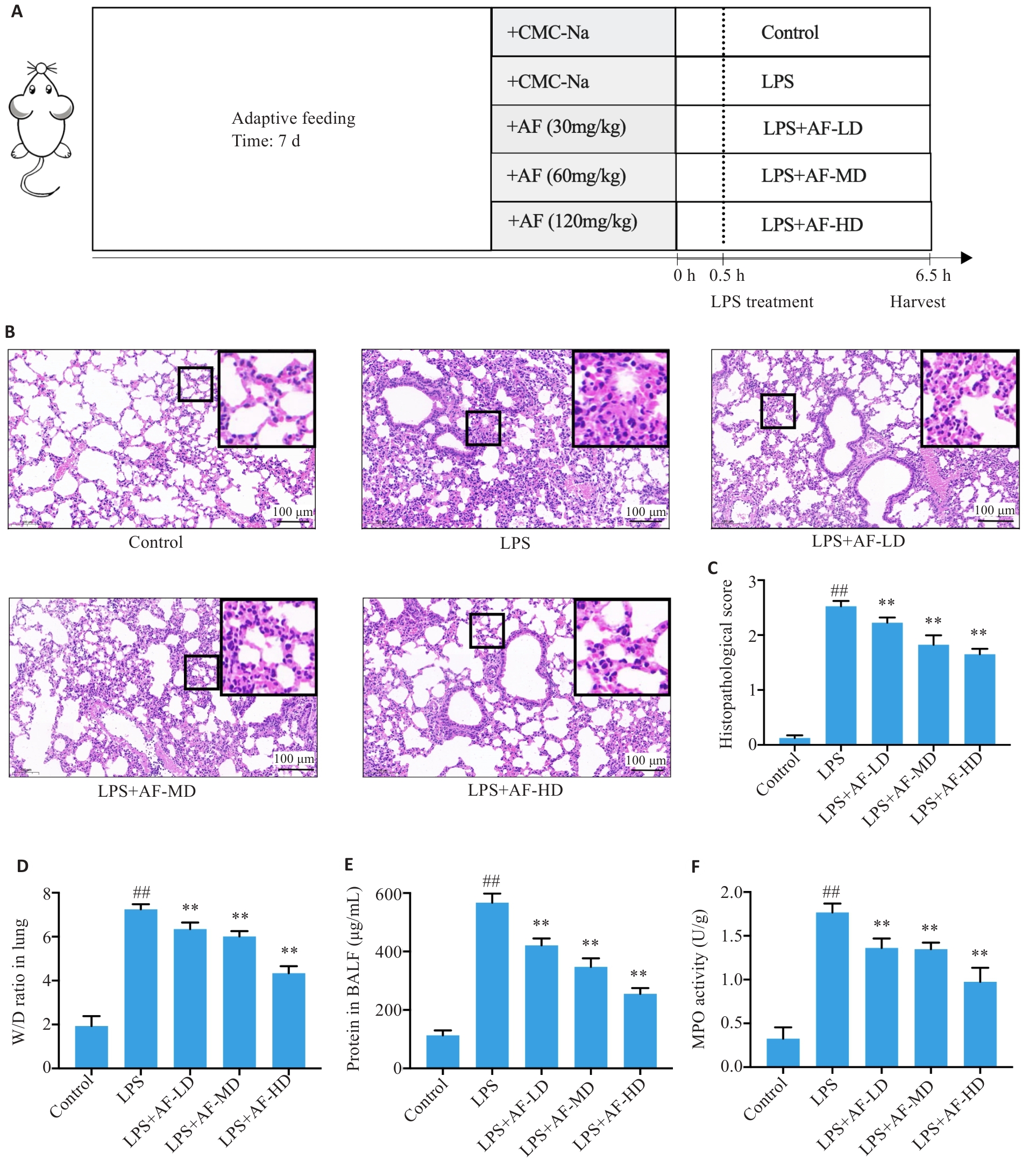
Fig.1 Pathological changes and inflammatory response in the lung tissue of the mice in different groups (Mean±SD). A: Protocols for treatment of the mice. B: HE stainin of mouse lung tissue sections. C: Mouse lung histopathological scores (n=4). D: Wet/Dry ratio of mouse lung tissue (n=4). E: Protein levels in BALF (n=6). F: MPO levels in mouse lung tissue (n=6). ##P<0.01 vs Control group. **P<0.01 vs LPS group.
| Gene | Forward primer | Reverse primer |
|---|---|---|
| IL-1β | TCG CAG CAG CAC ATC AAC AAG AG | AGG TCC ACG GGA AAG ACA CAG G |
| IL-6 | CTC CCA ACA GAC CTG TCT ATA C | CCA TTG CAC AAC TCT TTT CTC A |
| IL-18 | CAAAGTGCCAGTGAACCCCAGAC | ACAGAGAGGGTCACAGCCAGTC |
| TNF-ɑ | CAC GCT CTT CTG TCT ACT GAA CTT C | CTT GGT GGT TTG TGA GTG TGA GG |
| GAPDH | AGG TCG GTG TGA ACG GAT TTG | GGG GTC GTT GAT GGC AAC A |
Tab.1 Primer sequences for RT-qPCR
| Gene | Forward primer | Reverse primer |
|---|---|---|
| IL-1β | TCG CAG CAG CAC ATC AAC AAG AG | AGG TCC ACG GGA AAG ACA CAG G |
| IL-6 | CTC CCA ACA GAC CTG TCT ATA C | CCA TTG CAC AAC TCT TTT CTC A |
| IL-18 | CAAAGTGCCAGTGAACCCCAGAC | ACAGAGAGGGTCACAGCCAGTC |
| TNF-ɑ | CAC GCT CTT CTG TCT ACT GAA CTT C | CTT GGT GGT TTG TGA GTG TGA GG |
| GAPDH | AGG TCG GTG TGA ACG GAT TTG | GGG GTC GTT GAT GGC AAC A |
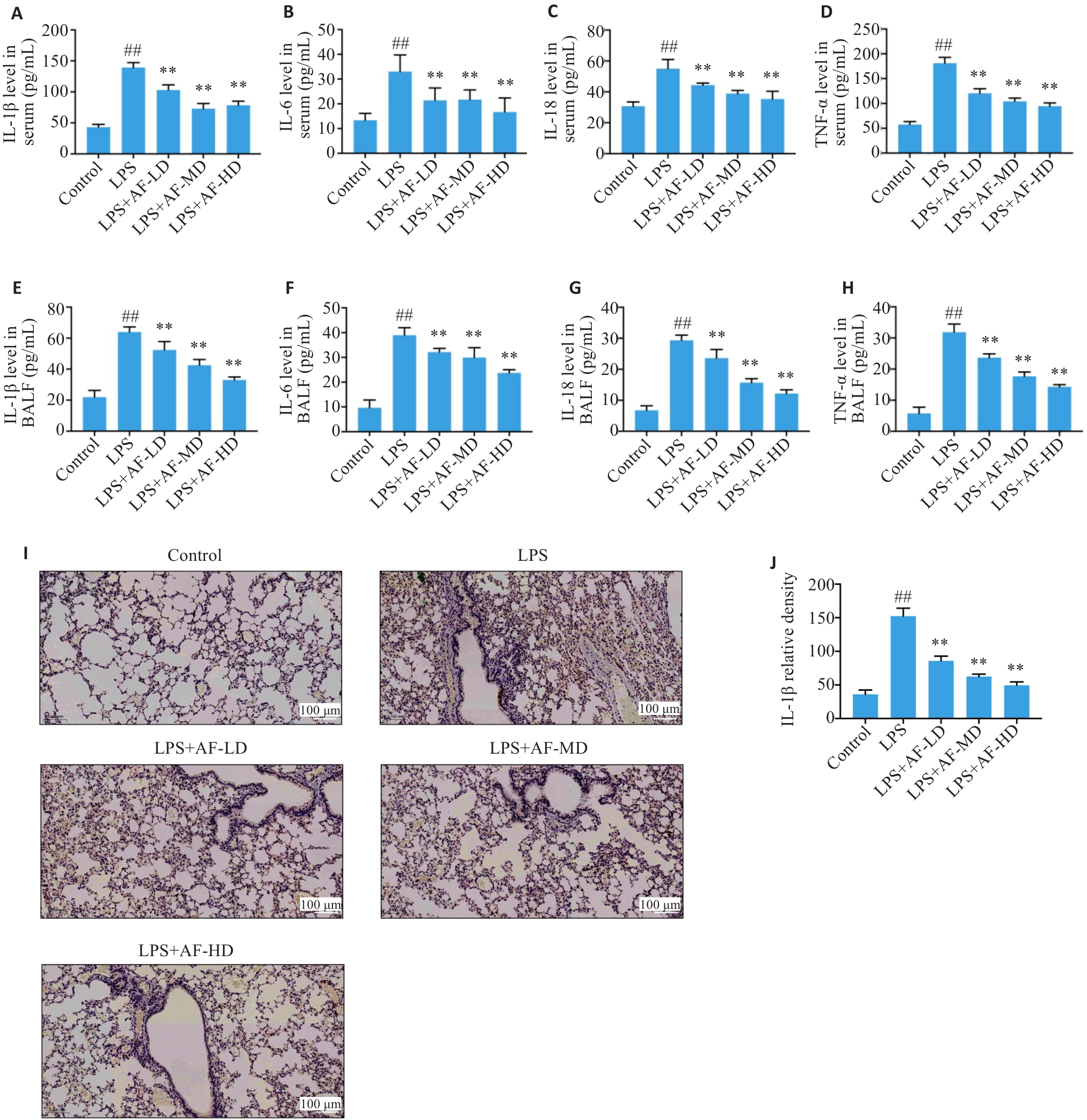
Fig. 2 Levels of inflammatory cytokines in the lung tissue of the mice in different groups (Mean±SD, n=6). A-D: Serum levels of IL-1β, IL-6, IL-18 and TNF‑α. E-H: Levels of IL-1β, IL-6, IL-18 and TNF‑α in BALF. I-J: Immunohistochemical results and quantitative analysis of IL-1β in lung tissue (scale bar=100 μm). ##P<0.01 vs Control group. **P<0.01 vs LPS group.
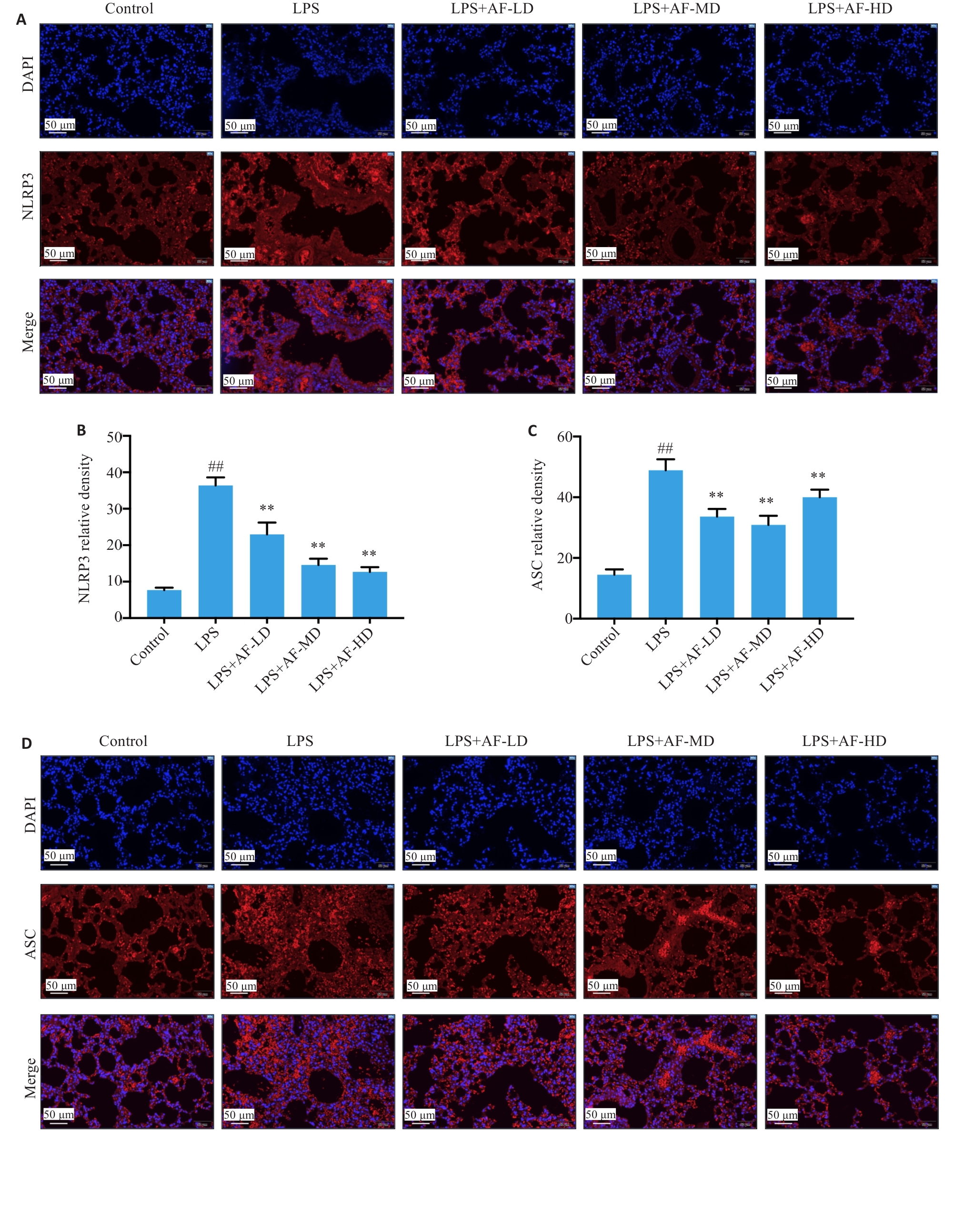
Fig.3 NLRP3 and ASC levels in the lung tissue of the mice in different groups (Mean±SD, n=6). A: NLRP3 immunofluorescence results. B, C: Quantitative analysis of immunofluorescence results. D: ASC immunofluorescence results. ##P<0.01 vs Control group. **P<0.01 vs LPS group.
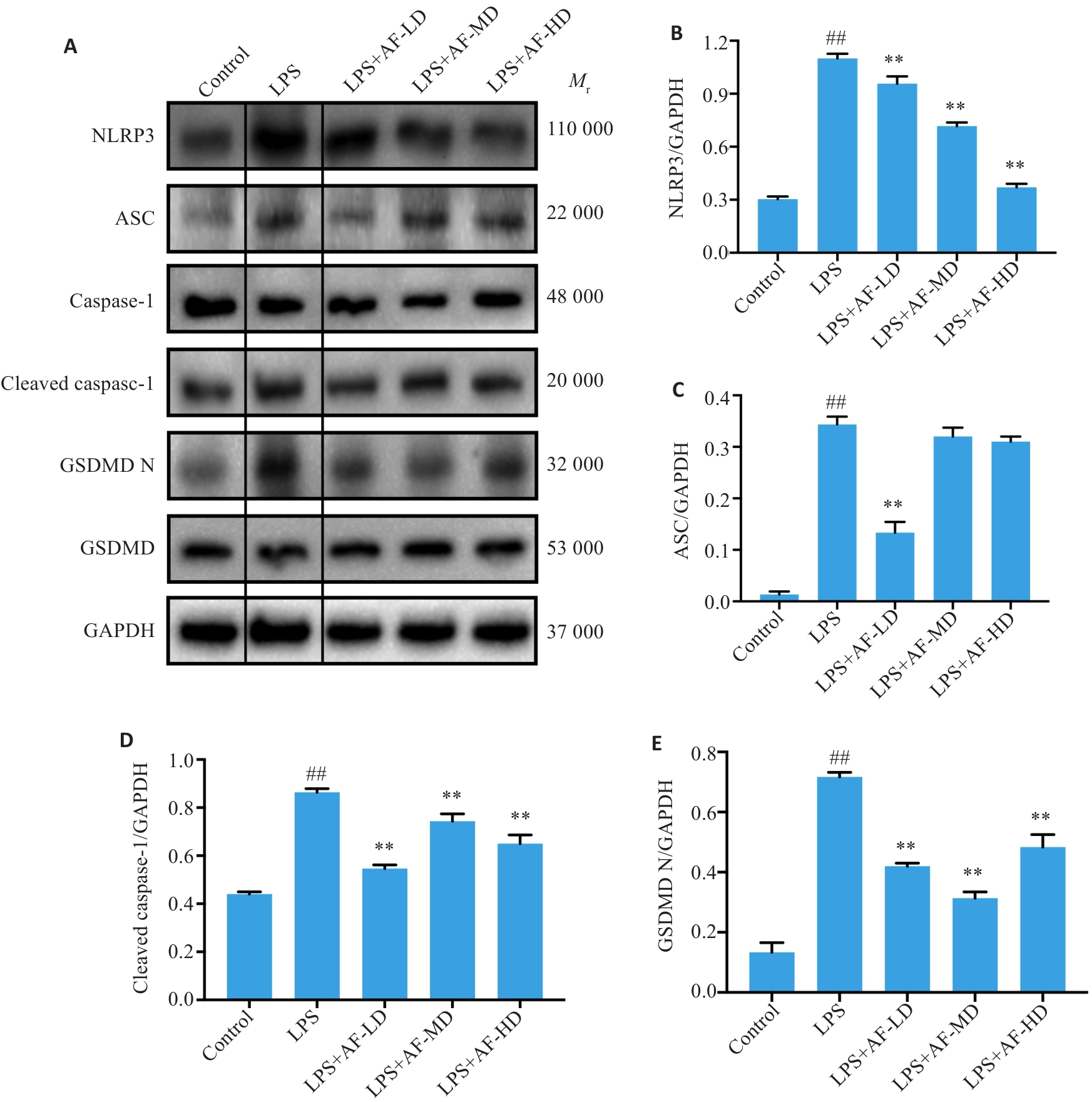
Fig.4 Activation of the NLRP3/ASC/Caspase-1 axis and pyroptosis level of in RAW264.7 cells with different treatments (Mean±SD, n=3). A: Western blotting of the proteins. B-E: quantitative analysis of the protein levels. ##P<0.01 vs Control group. **P<0.01 vs LPS group.
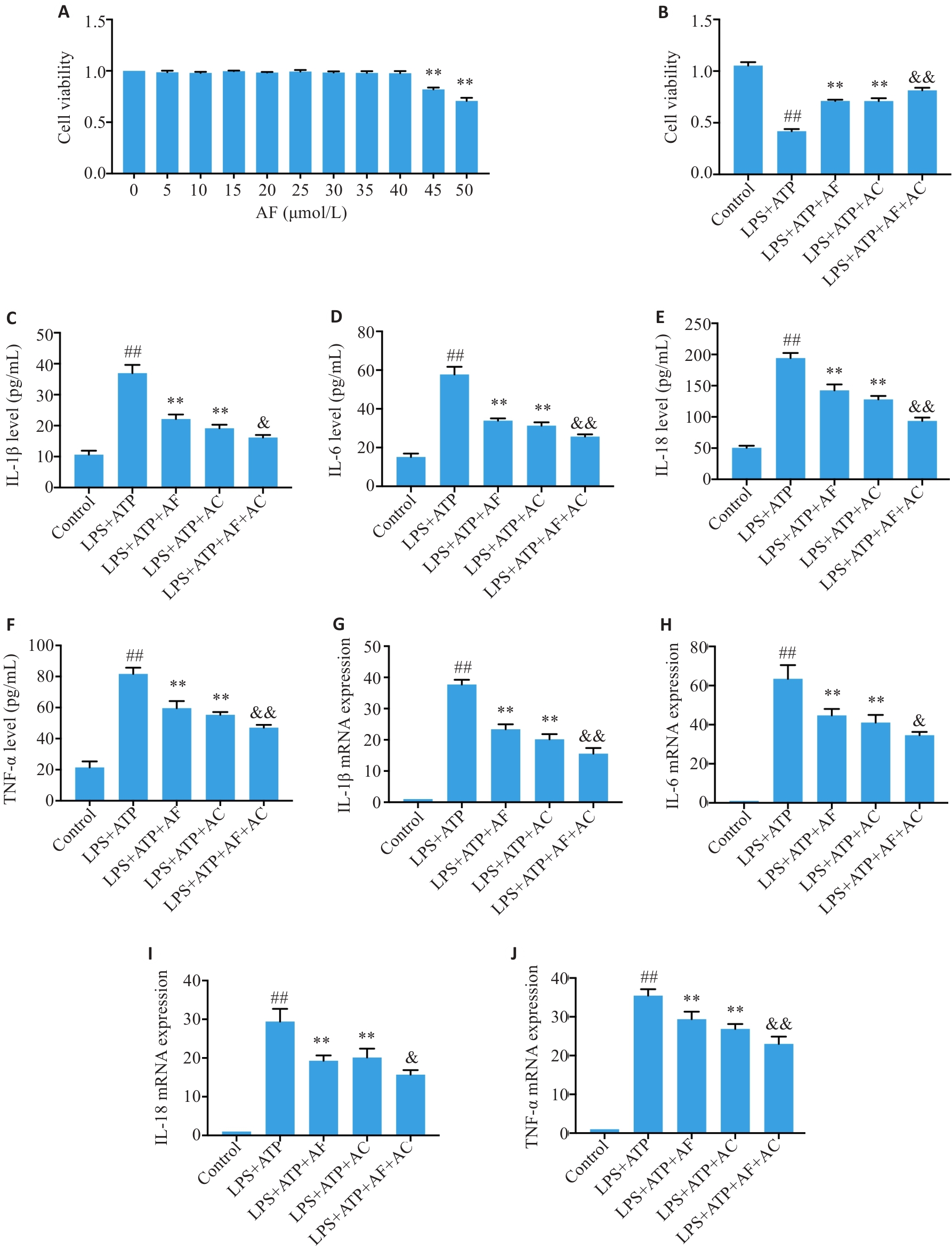
Fig.5 Proliferative toxicity, cell viability and inflammatory response in RAW264.7 cells with different treatments. A: Viability of the cells treated with different concentrations of AF (n=3). B: Viability of RAW264.7 cells with different treatments (n=3). C-F: Levels of inflammatory cytokines IL-1β, IL-6, IL-18, and TNF-α in the cells (n=6). G-J: mRNA levels of inflammatory cytokines IL-1β, IL-6, IL-18, and TNF‑α in the cells (n=6). ##P<0.01 vs Control group. **P<0.01 vs LPS+ATP group. &&P<0.01 vs LPS+ATP+AC and LPS+ATP+AF group. &P<0.05 vs LPS+ATP+AC and LPS+ATP+AF group.
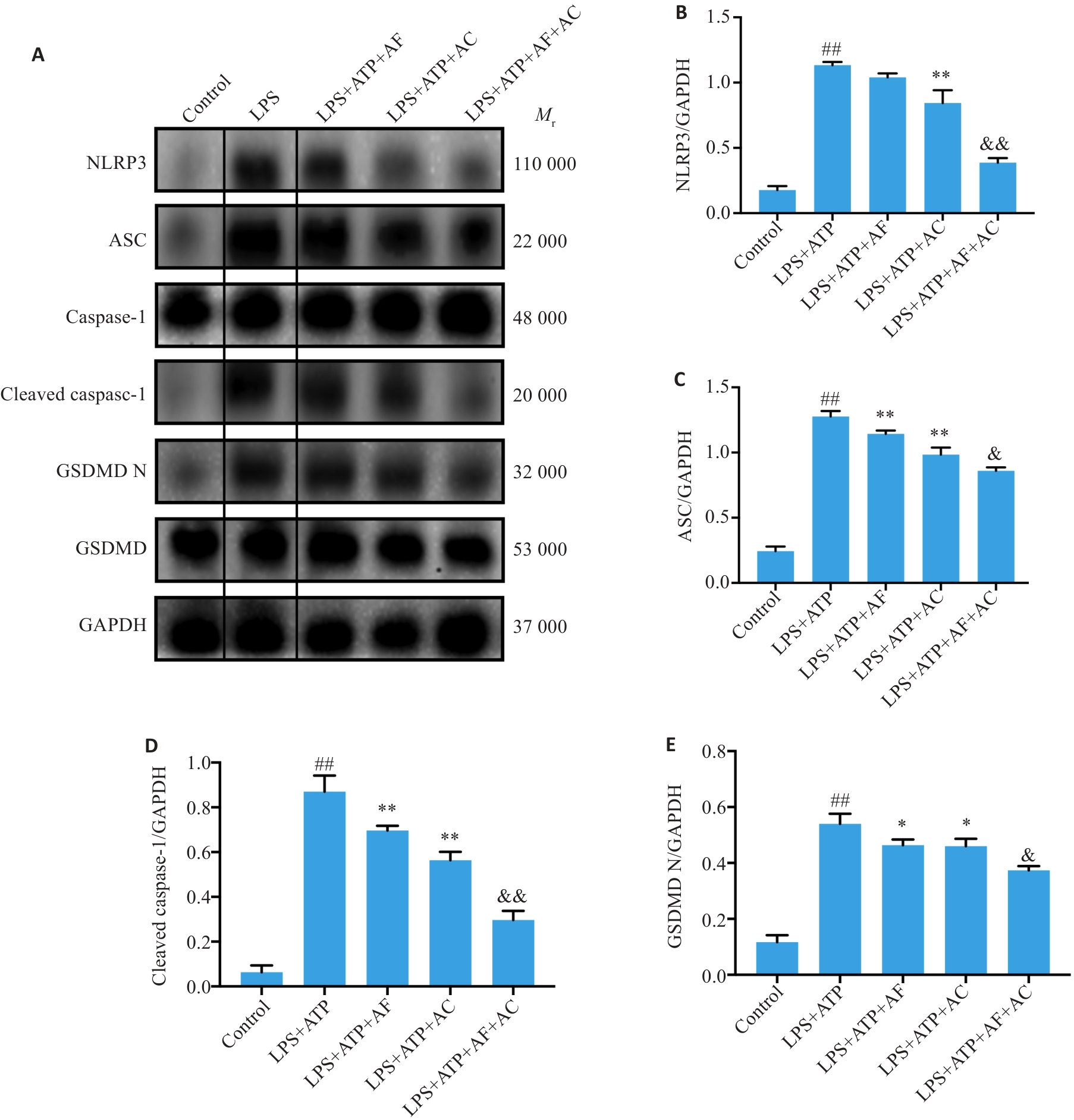
Fig.6 Activation of the NLRP3/ASC/Caspase-1 axis and pyroptosis of RAW264.7 cells with different treatments (Mean±SD, n=3). A: Western blotting of the proteins. B-E: quantitative analysis of the protein levels. ##P<0.01 vs Control group; *P<0.05, **P<0.01 vs LPS+ATP group; &P<0.05, &&P<0.01 vs LPS+ATP+AC and LPS+ATP+AF groups.
| 1 | Fan C, Zhang Z, Lai Z, et al. Chemical evolution and biological evaluation of natural products for efficient therapy of acute lung injury[J]. Adv Sci: Weinh, 2024, 11(7): e2305432. |
| 2 | Fan E, Brodie D, Slutsky AS. Acute respiratory distress syndrome: advances in diagnosis and treatment[J]. JAMA, 2018, 319(7): 698-710. |
| 3 | Bellani G, Laffey JG, Pham T, et al. Epidemiology, patterns of care, and mortality for patients with acute respiratory distress syndrome in intensive care units in 50 countries[J]. JAMA, 2016, 315(8): 788-800. |
| 4 | Huang X, Zhang R, Fan G, et al. Incidence and outcomes of acute respiratory distress syndrome in intensive care units of mainland China : a multicentre prospective longitudinal study[J]. Crit Care, 2020, 24(1): 515. |
| 5 | Gu W, Zeng Q, Wang X, et al. Acute lung injury and the NLRP3 inflammasome[J]. J Inflamm Res, 2024, 17: 3801-13. |
| 6 | Zhou S, Yang X, Mo K, et al. Pyroptosis and polarization of macrophages in septic acute lung injury induced by lipopolysaccharide in mice[J]. Immun Inflamm Dis, 2024, 12(3): e1197. |
| 7 | 鲁曼霞, 黄可龙, 施树云, 等. 兖州卷柏化学成分及体外抗菌活性研究[J]. 天然产物研究与开发, 2009, 21(6): 973-5. |
| 8 | Tuli HS, Joshi H, Vashishth K, et al. Chemopreventive mechanisms of amentoflavone: recent trends and advancements[J]. Naunyn Schmiedeberg's Arch Pharmacol, 2023, 396(5): 865-76. |
| 9 | Hou T, Yang M, Yan K, et al. Amentoflavone ameliorates carrageenan-induced pleurisy and lung injury by inhibiting the NF-κB/STAT3 pathways via Nrf2 activation[J]. Front Pharmacol, 2022, 13: 763608. |
| 10 | Li X, Huang R, Liu K, et al. Fucoxanthin attenuates LPS-induced acute lung injury via inhibition of the TLR4/MyD88 signaling axis[J]. Aging: Albany NY, 2020, 13(2): 2655-67. |
| 11 | 蔡 楠. 基于SIRT1-NLRP3信号通路探究姜黄素调节细胞焦亡改善急性肺损伤的作用机制[D]. 南京: 南京中医药大学, 2022. |
| 12 | Zhang BH, Luo L, Xiong SQ, et al. Anisodamine hydrobromide ameliorates acute lung injuryviainhibiting pyroptosis in murine sepsis model[J]. Immunopharmacol Immunotoxicol, 2024, 46(5): 662-71. |
| 13 | Zhang S, Zhao XY, Xue YH, et al. Advances in nanomaterial-targeted treatment of acute lung injury after burns[J]. J Nanobiotechnol, 2024, 22(1): 342. |
| 14 | Huppert LA, Matthay MA, Ware LB. Pathogenesis of acute respiratory distress syndrome[J]. Semin Respir Crit Care Med, 2019, 40(1): 31-9. |
| 15 | Millar FR, Summers C, Griffiths MJ, et al. The pulmonary endothelium in acute respiratory distress syndrome: insights and therapeutic opportunities[J]. Thorax, 2016, 71(5): 462-73. |
| 16 | 严双凤, 徐志波. 穗花杉双黄酮对脂多糖致大鼠急性肺损伤的保护作用及机制研究[J]. 浙江中西医结合杂志, 2020, 30(7): 530-4, 609. |
| 17 | Zong Y, Zhang H. Amentoflavone prevents sepsis-associated acute lung injury through Nrf2-GCLc-mediated upregulation of glutathione[J]. Acta Biochim Pol, 2017, 64(1): 93-8. |
| 18 | Shen Y, He Y, Pan Y, et al. Role and mechanisms of autophagy, ferroptosis, and pyroptosis in sepsis-induced acute lung injury[J]. Front Pharmacol, 2024, 15: 1415145. |
| 19 | Jin X, Ma Y, Liu D, et al. Role of pyroptosis in the pathogenesis and treatment of diseases[J]. MedComm: 2020, 2023, 4(3): e249. |
| 20 | Dai Z, Liu WC, Chen XY, et al. Gasdermin D-mediated pyroptosis: mechanisms, diseases, and inhibitors[J]. Front Immunol, 2023, 14: 1178662. |
| 21 | Wang C, Ruan J. An ancient defense mechanism: Conservation of gasdermin-mediated pyroptosis[J]. PLoS Biol, 2023, 21(5): e3002103. |
| 22 | Huston HC, Anderson MJ, Fink SL. Pyroptosis and the cellular consequences of gasdermin pores[J]. Semin Immunol, 2023, 69: 101803. |
| 23 | Wei Y, Yang L, Pandeya A, et al. Pyroptosis-induced inflammation and tissue damage[J]. J Mol Biol, 2022, 434(4): 167301. |
| 24 | Jiang P, Jin Y, Sun M, et al. Extracellular histones aggravate inflammation in ARDS by promoting alveolar macrophage pyroptosis[J]. Mol Immunol, 2021, 135: 53-61. |
| 25 | Liu C, Zhou Y, Tu Q, et al. Alpha-linolenic acid pretreatment alleviates NETs-induced alveolar macrophage pyroptosis by inhibiting pyrin inflammasome activation in a mouse model of sepsis-induced ALI/ARDS[J]. Front Immunol, 2023, 14: 1146612. |
| 26 | Kinra M, Nampoothiri M, Arora D, et al. Reviewing the importance of TLR-NLRP3-pyroptosis pathway and mechanism of experi-mental NLRP3 inflammasome inhibitors[J]. Scand J Immunol, 2022, 95(2): e13124. |
| 27 | Schwarzer R, Laurien L, Pasparakis M. New insights into the regulation of apoptosis, necroptosis, and pyroptosis by receptor interacting protein kinase 1 and caspase-8[J]. Curr Opin Cell Biol, 2020, 63: 186-93. |
| 28 | Chai R, Li Y, Shui L, et al. The role of pyroptosis in inflammatory diseases[J]. Front Cell Dev Biol, 2023, 11: 1173235. |
| 29 | 刘培培. 间充质干细胞来源外泌体抑制巨噬细胞焦亡减轻急性肺损伤及参附注射液治疗肺纤维化的研究[D]. 北京: 北京协和医学院, 2021. |
| 30 | Shen CS, Zhang ZG, Xie T, et al. Jinxin oral liquid inhibits human respiratory syncytial virus-induced excessive inflammation associated with blockade of the NLRP3/ASC/Caspase-1 pathway[J]. Biomed Pharmacother, 2018, 103: 1376-83. |
| [1] | Ju HUANG, Lixia YIN, Minzhu NIU, Zhijun GENG, Lugen ZUO, Jing LI, Jianguo HU. Nodakenin ameliorates TNBS-induced experimental colitis in mice by inhibiting pyroptosis of intestinal epithelial cells [J]. Journal of Southern Medical University, 2025, 45(2): 261-268. |
| [2] | Yiming SUN, Rong ZHANG, Ying MENG, Lei ZHU, Mingqiang LI, Zhe LIU. Coenzyme Q10 alleviates depression-like behaviors in mice with chronic restraint stress by down-regulating the pyroptosis signaling pathway [J]. Journal of Southern Medical University, 2024, 44(5): 810-817. |
| [3] | FANG Shangping, SUN Renke, SU Hui, ZHAI Kecheng, XIANG Yu, GAO Yangmengna, GUO Wenjun. Chlorogenic acid alleviates acute kidney injury in septic mice by inhibiting NLRP3 inflammasomes and the caspase-1 canonical pyroptosis pathway [J]. Journal of Southern Medical University, 2024, 44(2): 317-323. |
| [4] | LING Xuguang, XU Wenwen, PANG Guanlai, HONG Xuxing, LIU Fengqin, LI Yang. Tea polyphenols ameliorates acute lung injury in septic mice by inhibiting NLRP3 inflammasomes [J]. Journal of Southern Medical University, 2024, 44(2): 381-386. |
| [5] | Duanyi SONG, Yun LI, Xuefang TANG, Hua LI, Kang TAO. Diazepam alleviates pulmonary fibrosis in mice by inhibiting LPS-induced pyroptosis and inflammation via the let-7a-5p/MYD88 axis [J]. Journal of Southern Medical University, 2024, 44(11): 2092-2101. |
| [6] | Li MEI, Lu ZHANG, Di WU, Huanzhang DING, Xinru WANG, Xian ZHANG, Yuhang WEI, Zegeng LI, Jiabing TONG. Liuwei Buqi Formula delays progression of chronic obstructive pulmonary disease in rats by regulating the NLRP3/caspase-1/GSDMD pyroptosis pathway [J]. Journal of Southern Medical University, 2024, 44(11): 2156-2162. |
| [7] | Ruoli DU, Qi YUN, Yiren WANG, Xinyu DOU, Hongwei YE, Jiahui WANG, Qin GAO. Plumbagin protect against sepsis-induced myocardial injury in mice by inhibiting the JAK2/STAT3 signaling pathway to reduce cardiomyocyte pyroptosis [J]. Journal of Southern Medical University, 2024, 44(11): 2209-2219. |
| [8] | Ping SHU, Mengke YUAN, Ke YANG, Weizhi HE, Li LIU. Quercetin suppresses pyroptosis in mouse fibroblasts by inhibiting the NLRP3/caspase-1/GSDMD pathway [J]. Journal of Southern Medical University, 2024, 44(10): 1874-1880. |
| [9] | KONG Xiang, ZHANG Teng, ZHANG Yan, GAO Linxi, WANG Wen, WANG Mengyan, WANG Guodong, LÜ Kun. Overexpression of lncRNA HEM2M alleviates liver injury in mice with non-alcoholic fatty liver disease [J]. Journal of Southern Medical University, 2024, 44(1): 1-8. |
| [10] | WU Di, WANG Xiaole, GAO Yating, TONG Jiabing, YANG Qinjun, DING Huanzhang, ZHANG Lu, LI Zegeng. Shenqi Wenfei Formula alleviates chronic obstructive pulmonary disease in rats with pulmonary qi deficiency syndrome by regulating NLRP3/GSDMD pyroptosis pathway [J]. Journal of Southern Medical University, 2023, 43(9): 1500-1508. |
| [11] | LI Hongtao, DENG Yu, WANG Tianle, HUANG Keyong, YU Chuanpei, CHEN Chaojun. Danshenxinkun B protects human umbilical vein endothelial cells against ox-LDL-induced injury by inhibiting pyroptosis and the NF-κB/NLRP3 pathway [J]. Journal of Southern Medical University, 2023, 43(8): 1425-1431. |
| [12] | WANG Liya, TIAN Meihui, LI Rong, WU Yue, WANG Shasha, LÜ Heng, LIU Zhongyi, YU Ying. Acetaldehyde dehydrogenase 2 ameliorates lung endothelial barrier and balances mitochondrial dynamics in mice with acute lung injury [J]. Journal of Southern Medical University, 2023, 43(8): 1388-1395. |
| [13] | ZHANG Meng, ZHANG Yuanyuan, NIU Mengzhu, ZHU Yue, TONG Shiyi, KOU Xianjuan. Dihydromyricetin alleviates pyroptosis and necroptosis in mice with MPTP-induced chronic Parkinson's disease by inducing autophagy [J]. Journal of Southern Medical University, 2023, 43(8): 1268-1278. |
| [14] | LI Peipei, HU Yinqi, LIU Jia, WANG Lina, WU Yuanjie, HU Jianpeng. Naoluo Xintong Decoction activates caspase-1/Gasdermin D pathway to promote angiogenesis of rat brain microvascular endothelial cells after oxygen glucose deprivation/reperfusion injury [J]. Journal of Southern Medical University, 2023, 43(7): 1093-1101. |
| [15] | JIANG Yong, GE Wenting, ZHAO Ying, WU Yuge, HUO Yiming, PAN Lanting, CAO Shuang. LINC00926 promotes pyroptosis of hypoxia-induced human umbilical vein vascular endothelial cells by recruiting ELAVL1 [J]. Journal of Southern Medical University, 2023, 43(5): 807-814. |
| Viewed | ||||||
|
Full text |
|
|||||
|
Abstract |
|
|||||